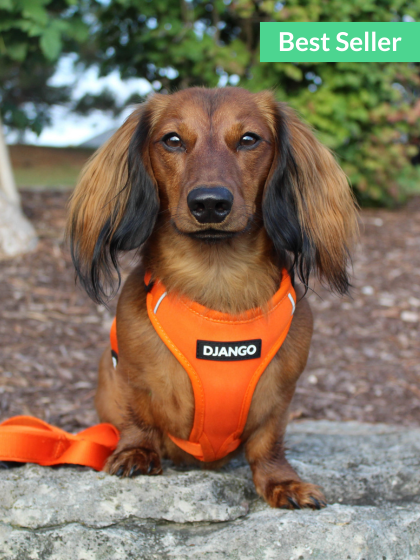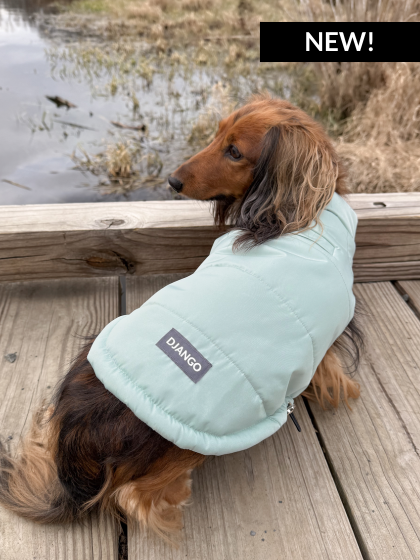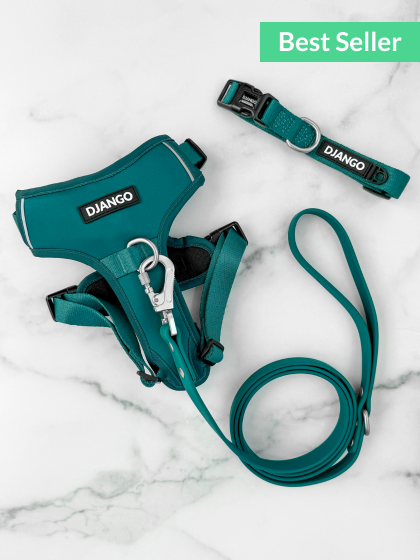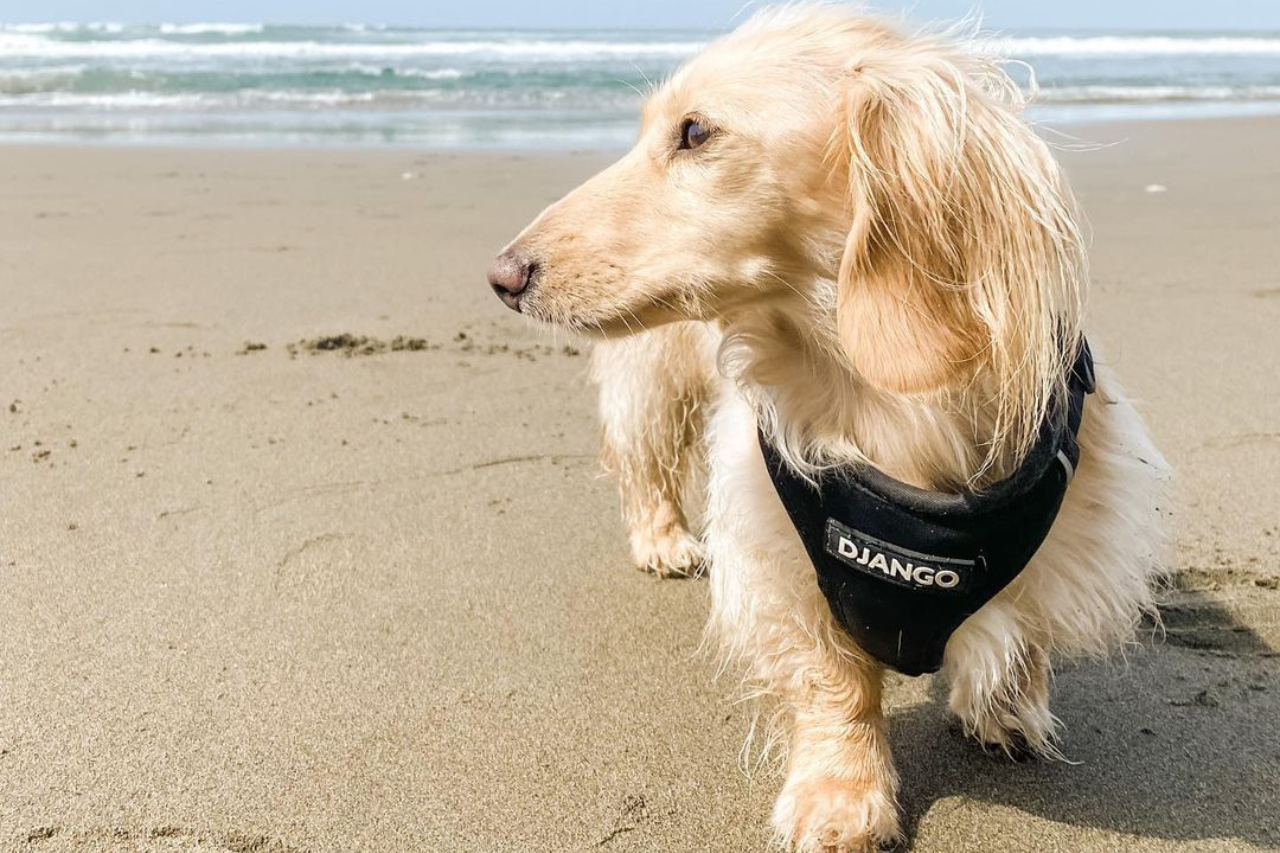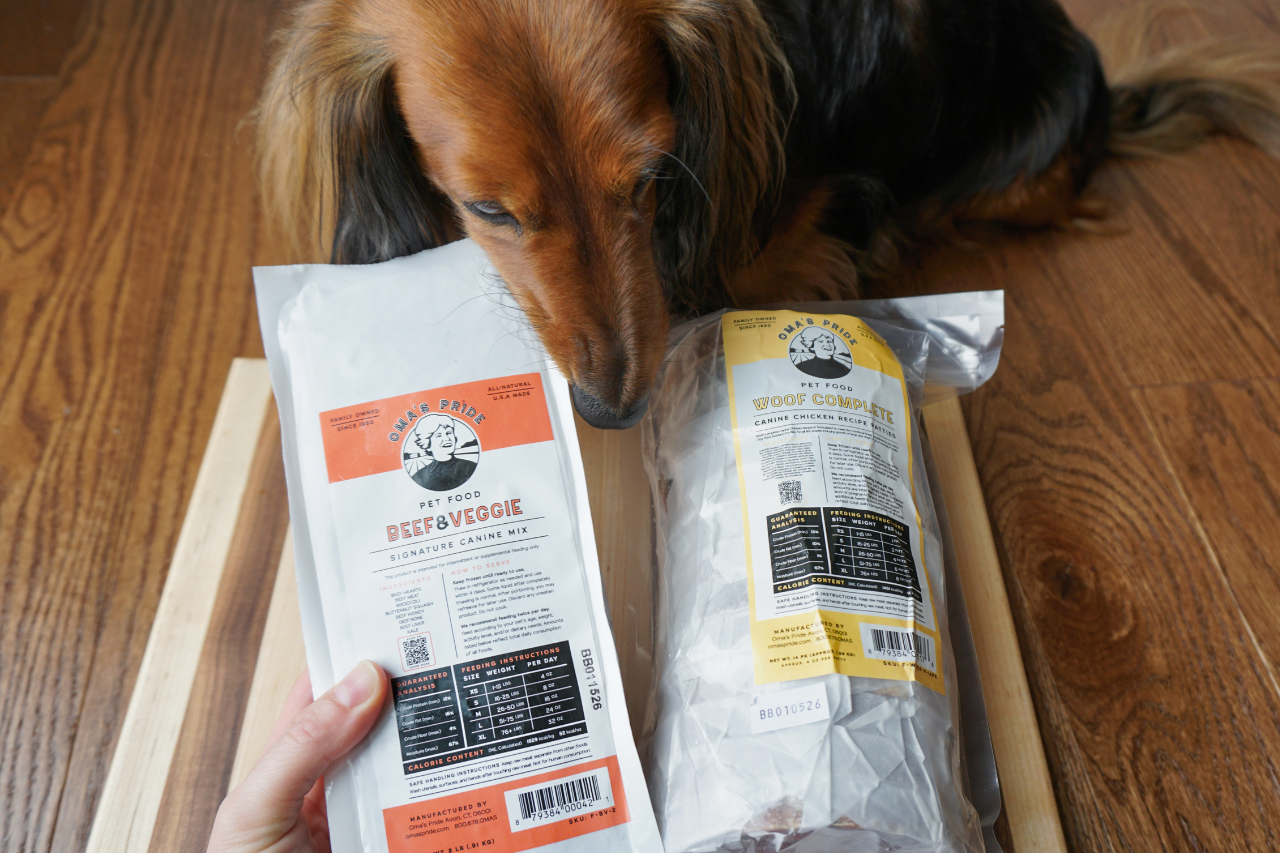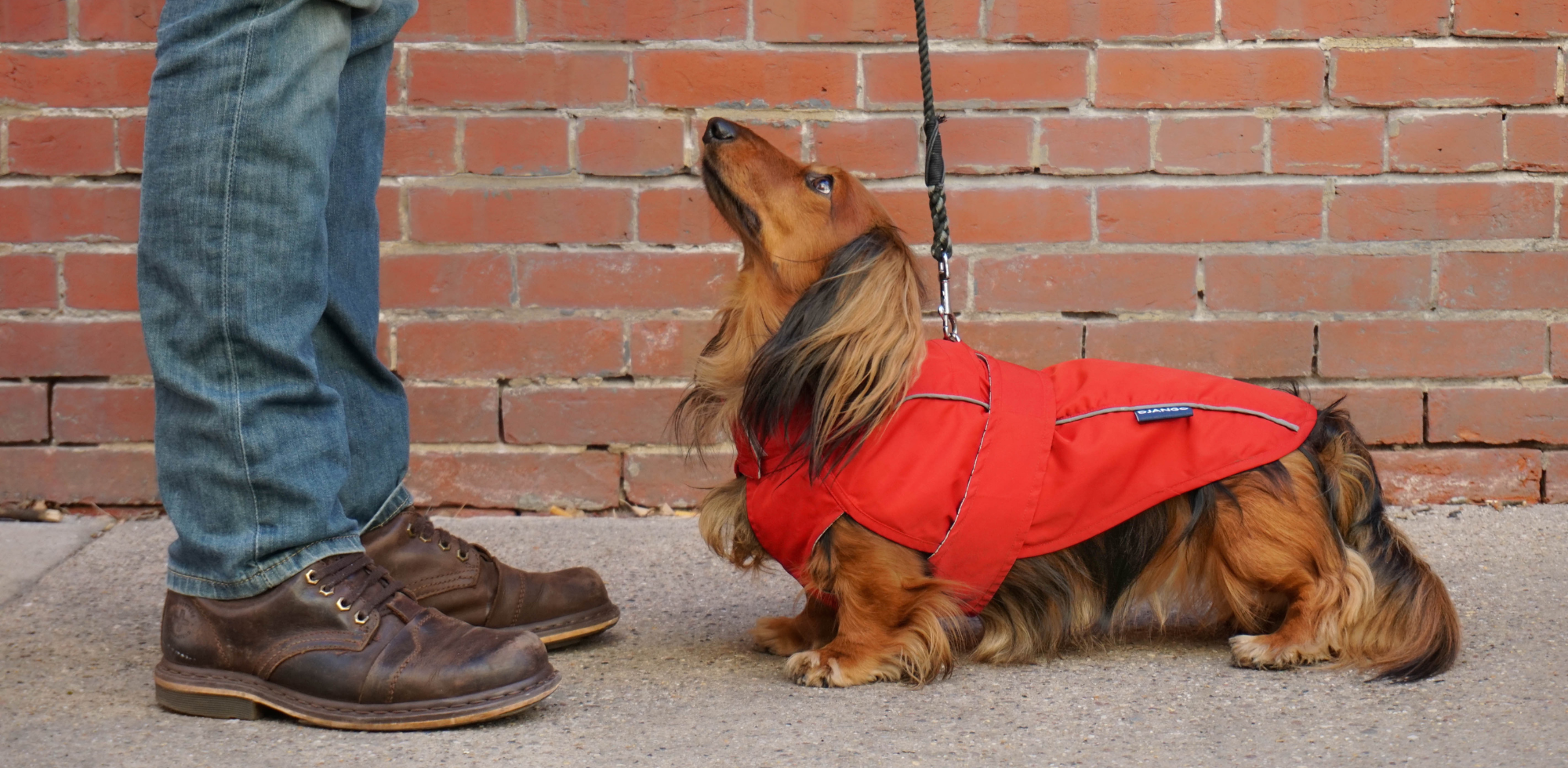Intervertebral Disc Disease (IVDD) is a scary and heartbreaking diagnosis. The last thing any loving dog parent wants is for their four-legged family to suffer from pain, discomfort, immobility, or even paralysis.
We (Steph and Mike) know from experience. Two years ago, our longhaired dachshund, Django, suffered from Stage 4 IVDD and temporary paralysis in his rear legs. After emergency IVDD surgery and months of recovery, he fortunately regained use of his back legs and lives a happy and active life today.
Our dachshund's positive IVDD recovery story is one you see often on Instagram and TikTok. An adorable dachshund suffers from IVDD, has surgery, and recovers beautifully over time. What about dachshunds with the most severe cases of IVDD—when spinal cord compression leads to paralysis that cannot be reversed with surgery?
In this DJANGO Dog Blog article, we talk with doxie mom Suzanne to learn about her sausage dog Claire's Stage 5 IVDD diagnosis. We hear about Claire's injury, discuss Suzanne's experience of going through such a traumatic ordeal, and get a glimpse into Claire's joyful and adventurous life today.
It is so nice to speak with you, Suzanne! Tell us a little about your family and life. Where do you live, and how many dachshunds do you have?
I’m originally from Arlington, Virginia, but we moved to Switzerland almost 3 years ago. We’re living in the only part of Switzerland that speaks Italian, right on the border of Italy.
I’ve had dachshunds all my life. Finnegan and Claire are my seventh and eighth doxies. Finnegan turned 6 this past December, and Claire turned 5 in January. They have very different personalities. Finnegan is the “Greeter”—he loves people with passion and never forgets those that he’s chosen. Claire is the “Snuggler"—she always wants to be touching you.

Finnegan and Claire sound so loving and sweet-natured! And based on your Instagram account, your life in Switzerland looks magical and adventurous.
Was Claire always an adventure dog? How active and adventuresome was she before her IVDD symptoms and diagnosis?
Before IVDD, Claire was very active. She loved exploring the trails here in Switzerland. When she discovered Swiss lizards, she fell in love.
As adventurous as she was (and still is), she is also a loving lap dog. Before IVDD she followed me everywhere and loved to fall asleep with her paw in my hand, She would wake up in the middle of the night and come along the outside edge of the bed if my back was to her so she could snuggle up as the little spoon.
Claire sounds like a true doxie! Adventurous, bold, and ready to hit the trails... yet also a true lover and always ready to snuggle and be held like a baby.
How old was Claire when she developed IVDD?
She had just had her 3rd birthday a couple of weeks before.
What caused Claire’s injury, if anything? Was there an accident or event that you can pinpoint, or did her IVDD seem to come out of nowhere?
I ask because our dachshund Django's IVDD seemed to come out of nowhere. I can remember the moment Django suddenly began trembling while we were inside our home. He didn't jump, fall, or twist (from what I could see, at least). One moment he was fine, and the next he was trembling in pain with his head between my legs as I comforted him.
I can’t say for sure that something didn’t happen when I wasn’t watching, but it seemed to come out of nowhere. We had done a long walk the day before, and Claire woke up in pain the next morning.
Were Claire’s IVDD symptoms minor at first? Or did major IVDD symptoms come on all at once?
Claire's pain level was so great that morning, that I phoned my vet as soon as they opened. Unfortunately, my vet refused to give Claire an appointment that day. She referred me to an orthopedic specialist who couldn’t give me an appointment for 2 weeks.
By 1:00 pm, Claire couldn’t move her legs anymore. I took her to an emergency vet who tried to get her a neurology appointment, but they could not find an appointment until the next morning.
That must have been such a scary and heart-wrenching day and night—seeing Claire suffer and knowing that she would not get medical attention until the next morning.
That night was horrific! Even though Claire received a shot to help with discomfort, she was in extreme pain and panting. Plus, Claire hadn’t peed since the morning. I was worried that she would suffer from damage to her bladder and kidneys.

What stage of IVDD was Claire officially diagnosed with the next day? And what was her official prognosis?
Claire was diagnosed with stage 5 IVDD, and after magnetic resonance imaging (MRI), she was given a 40% chance of walking again. By the time Claire reached the canine neurologist, she no longer had any deep pain sensation.
For our readers, once a dog loses deep pain sensation (and is considered chronically “deep pain negative"), he or she is unlikely to walk normally again, is likely to be permanently paralyzed, and may also lose bladder and bowel control.
What did Claire's neurologist advise? You mentioned to me once before that your doctor suggested euthanasia, rather than surgery, which is so crazy and so heartbreaking to think.
The doctor was Italian. He suggested that I make a ‘difficult decision’ (meaning euthanasia) because I would probably be faced with it later.
But you moved forward with surgery. How did Claire's surgery go? Was it considered successful?
The surgery was considered successful. But they warned me that her spinal cord was very damaged, and she was likely to develop myelomalacia—progressive softening of the spine due to impaired blood flow to the spinal cord. This can develop in the first 3 days after surgery and is often fatal.
Can you was us through Claire's IVDD recovery—especially the early weeks?
Our first 2-3 weeks with Django after his IVDD surgery were especially difficult and gut-wrenching. He had no function of his back legs, bladder, or bowels. He was always uncomfortable and had tons of accidents in his crate. I had to figure out how to express Django's bladder since he could not pee on his own, which was difficult and confusing.
When followers of Django message us on Instagram about their dachshund's IVDD surgery, I am always honest about how difficult the first few weeks post-surgery may be. I also remind them that they will absolutely get through the hardest times!
I drove Claire directly from her surgery center in Switzerland to a rehabilitation facility in Italy. No one spoke English, so we had to use Google Translate for all of our conversations.
Each day, I would drive an hour into Italy to visit Claire. The medical technicians said Claire wasn’t peeing on her own. After 6 days, they said she wasn’t eating. Apparently Claire had not been eating the entire time she was there.
The rehab facility clearly wasn't a good fit for Claire, so we learned how to express her bladder and took her home. I continued to drive the hour trip there and back for 5 more aqua therapies. I felt we needed to give Claire the care and love she desperately needed.
Similar to Django, Claire had many accidents in her crate. We would bathe her after each one. Then she had to be dried with a hair dryer, because you can’t put a diaper on a wet dog. It was exhausting.
How was Claire during all of this?
Claire was very depressed during this time. You probably remember some of my DMs on Instagram at that time. I was worried because she was so unhappy. I wondered if I was doing the right thing for her.
Through it all, everyone kept telling me that it just takes time. That she would learn to walk again. And, to be honest, I can only count on 1½ hands the number of dachshunds on Instagram who didn’t walk again after IVDD surgery. It wasn’t until recently that I thought about this and realized that dogs like Claire usually don’t make it past the recommendation of euthanasia.
Again, the idea of a dog being euthanized due to IVDD is unfathomable. I imagine many loving dog owners dealing with IVDD have faced the same dilemma as you. Is fighting for the dog's life in the dog's best interest? Will the dog live a happy and fulfilling life with permanent paralysis?
What made you decide to invest in a dog wheelchair for Claire?
My new veterinarian suggested I get Claire a dog wheelchair. She seemed to know exactly the right kind and, for once, I didn’t do my own research but took her advice.
The wheels came disassembled, and they needed an engineer to build them. Claire didn’t like them from the very start. The dog wheelchair had a bar at the back, and the wheels would flip back and leave Claire hanging in the air. Her front paws would be waving, and she had no way to right herself.
When I mentioned these design issues to my vet, I was told “some dogs just don’t like to use wheels.” When I decided to investigate a different make of wheels, I was told I’d be wasting my money—if Claire didn’t like the ones she already had, she wouldn’t like any other kind.

Dog wheelchairs are complicated, expensive, and difficult to find. We receive countless emails from loving dog owners who are trying to find a reputable dog wheelchair company or dog wheelchair non-profit.
What was your next move?
After 5 or 6 weeks of Claire refusing her vet-recommended dog wheelchair, I called Eddie's Wheels. The company is based in Massachusetts, and they require a very specific set of dog measurements which I got with the help of my vet.
Claire's new wheels arrived in Switzerland completely built. I took them out of the box, put Claire in them, and she took off like she had been waiting all her life for them! She moved so easily and was able to go pretty fast—she was excited to have a new advantage over the lizards she loved to chase!
What was the cost of the dog wheelchair, if you don’t mind my asking? Whenever possible, I like to share these costs with our readers so they know what to expect.
I don’t remember the exact cost, but I think it was under $1,000. The new set of wheels was less than the first set.
Do you have any other advice for those that are considering a dog wheelchair for a paralyzed pup?
My takeaway on dog wheels is this—if your dog does not like his or her dog wheelchair, DO NOT listen to the common belief that some dogs don’t want to use wheels. If you can swing it, try a different make of wheels—even if you get them second hand.
Wheels are like our shoes. We all have the ones we wear all the time because they’re so comfortable and feel great no matter how much we do in them.
If you can find the right wheels, you give your pup the gift of mobility that was taken away from them when they became paralyzed.
How is Claire doing today? Tell us about your adventurous life in Switzerland and how Claire keeps up despite her paralysis and physical limitations.
Claire loves her life! Whenever we walk, people gather around her to take pictures. We hear calls of “carina” (cute) and “bellisima” (extremely beautiful).
We need to get a dog backpack carrier for hikes in places the wheels won’t go. Fortunately, Claire's Eddie's Wheels set are almost all-terrain. She does curbs and rocky ground well in them. We also have a good, sturdy dog stroller that has been invaluable.
We can help you with the dog backpack carrier! Our dog accessories and apparel brand, DJANGO, will be launching an incredible dog backpack carrier on djangobrand.com later this summer.
And unlike vertical-style dog backpack carriers which are dangerous for dachshunds and dog breeds with sensitive and/or injury-prone backs, ours is a horizontal-style backpack for dogs. This means that the dog will always be on all fours and always supported properly. There will never be pressure on the dog's spine due to an unnatural and upright position.
Has Claire's personality or temperament changed because of her paralysis and new way of life?
Dogs don’t think like people. They don’t wish it hadn’t happened. They live in the present. Our job is to provide an environment that makes them happy.
We’re forever grateful that we have Claire with us, and she has a great temperament. She is very social with other dogs, kids, and people. Her wonderful personality is a lifesaver, because we take her everywhere we go.
Your and Claire's IVDD story is so hopeful and uplifting. Despite everything challenging and terrible that you and Claire went through, it is so inspiring to see your dachshund living a joyful and active life today.
Can you offer any other advice to other dachshund or dog owners that are dealing with IVDD and/or considering a future with a newly paralyzed dog?
I ultimately want to give our readers hope that an IVDD diagnosis isn’t the end—a dog can still experience a beautiful, fulfilling, happy, and even active life despite permanent paralysis.
We dodged a bullet when I think about Claire and the euthanasia advice we were given.
Please don’t rush into a decision. It is overwhelming at the beginning, and I was filled with doubts about my abilities. But as with any new skill, you figure it out, and it becomes second nature. Now both my husband and I are so thankful that we have this precious girl to love. Claire has been a gift to us that we could never have foreseen.
One more piece of advice: do whatever you reasonably can to allow your dog to live in an environment where they have choices. Research shows that the lack of decisions an animal in captivity is able to make has a large impact on their happiness.
When Claire was first paralyzed, we lived in a house with stairs everywhere. She couldn’t do the stairs on her own so she would cry at the bottom of the stairs when I went up to the bedroom. Last summer we moved to a house that has a bedroom on the same floor as the living room, dining room, and kitchen. Claire can wake up each morning and follow us around—something that dachshunds love to do. She lives in a place where she can make those critical decisions for herself.
Thank you so much, Suzanne, for taking the time to talk to us and share your story. To see more inspiring photos and videos of Claire, follow her and her doxie brother, Finnegan, on Instagram: @mr_andsister.

